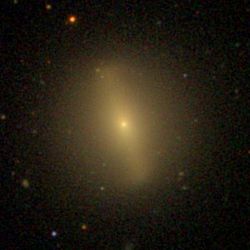NGC 4479 facts for kids
Quick facts for kids NGC 4479 |
|
|---|---|

SDSS image of NGC 4479.
|
|
| Observation data (J2000 epoch) | |
| Constellation | Coma Berenices |
| Right ascension | 12h 30m 18.4s |
| Declination | 13° 34′ 40″ |
| Redshift | 0.002922/876 km/s |
| Distance | 59.7 Mly |
| Group or cluster | Virgo Cluster |
| Type | SB0^0(s) |
| Apparent dimensions (V) | 1.38 x 1.10 |
| Apparent magnitude (V) | 13.4 |
| Other designations | |
| CGCG 70-134, MCG 2-32-100, PGC 41302, UGC 7646, VCC 1283 | |
| See also: Galaxy, List of galaxies | |
NGC 4479 is a fascinating galaxy located very far away in space. It's about 60 million light-years from Earth! This galaxy is a special type called a 'barred lenticular galaxy.' You can find it in the direction of the Coma Berenices constellation.
Contents
What is NGC 4479?
NGC 4479 is a type of galaxy. A galaxy is a huge collection of stars, gas, dust, and dark matter. These parts are all held together by gravity. Our own solar system, including Earth, is part of the Milky Way galaxy.
Lenticular Galaxies Explained
NGC 4479 is known as a lenticular galaxy. The word "lenticular" means lens-shaped. Imagine a flat disc, like a pancake, but without the swirling arms you see in spiral galaxies. Lenticular galaxies are often thought of as being in between spiral galaxies and elliptical galaxies. They have a central bulge of stars and a flat disk, but they don't have clear spiral arms. They also have very little gas and dust, which means they don't form many new stars.
The Barred Feature
This galaxy is also described as "barred." This means it has a bar-shaped structure made of stars. This bar goes through the center of the galaxy. About two-thirds of all spiral and lenticular galaxies have these bar structures. Scientists believe these bars help funnel gas and dust towards the galaxy's center. This can sometimes trigger new star formation there.
How Big is NGC 4479?
NGC 4479 is quite large. Scientists estimate it is about 26,860 light-years across. To give you an idea, our Milky Way galaxy is about 100,000 light-years wide. So, NGC 4479 is a significant size, holding billions of stars.
Where is NGC 4479 Located?
This galaxy is part of a much larger group of galaxies. It is located within the Virgo Cluster.
The Virgo Cluster
The Virgo Cluster is a massive group of galaxies. It is one of the closest large galaxy clusters to our own Local Group of galaxies. The Virgo Cluster contains over 1,300 galaxies, and possibly as many as 2,000! These galaxies are all bound together by gravity. Our Local Group is actually on the outer edge of the Virgo Supercluster, which is an even bigger structure that includes the Virgo Cluster.
Coma Berenices Constellation
NGC 4479 is found in the direction of the Coma Berenices constellation. A constellation is a group of stars that form a pattern in the night sky. People have imagined these patterns for thousands of years. Coma Berenices means "Berenice's Hair" in Latin. It's a faint constellation, but it's famous for containing many galaxies, including parts of the Virgo Cluster. When you look at Coma Berenices, you are looking towards a very busy part of the universe!
Measuring Distances in Space
The distance to NGC 4479 is given as 60 million light-years. This is an incredibly vast distance.
What is a Light-Year?
A light-year is a unit of distance, not time. It is the distance that light travels in one Earth year. Light moves incredibly fast, about 300,000 kilometers (186,000 miles) per second. So, one light-year is about 9.46 trillion kilometers (5.88 trillion miles). When we say NGC 4479 is 60 million light-years away, it means the light we see from it today started its journey 60 million years ago! This gives us a glimpse into the galaxy's past.
How We Study Distant Galaxies
Astronomers use powerful telescopes to study galaxies like NGC 4479. These telescopes collect light from distant objects. By analyzing this light, scientists can learn many things. They can figure out how far away a galaxy is, how fast it is moving, and what it is made of. The image of NGC 4479 in the infobox was taken by the Sloan Digital Sky Survey (SDSS). This project maps large parts of the universe.

